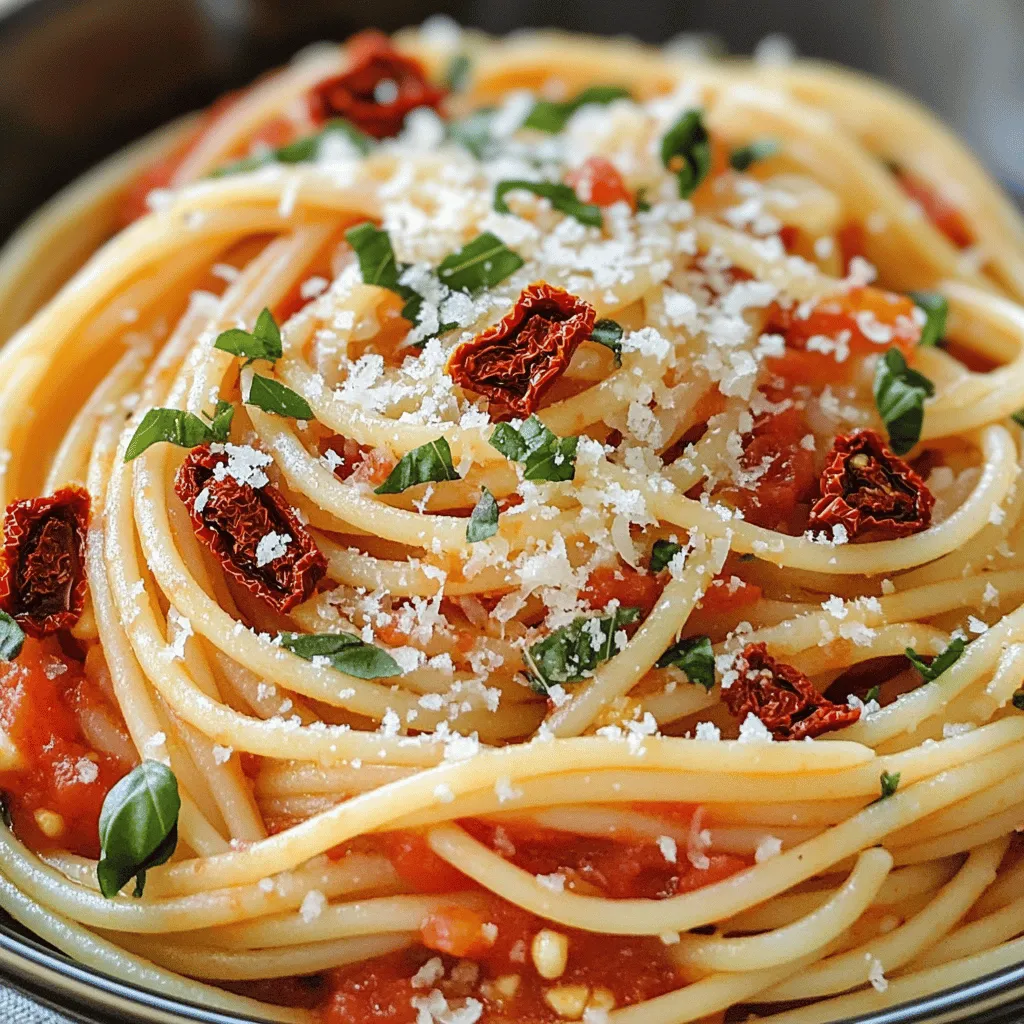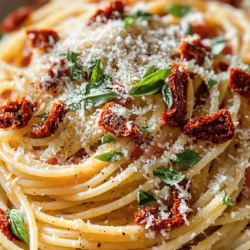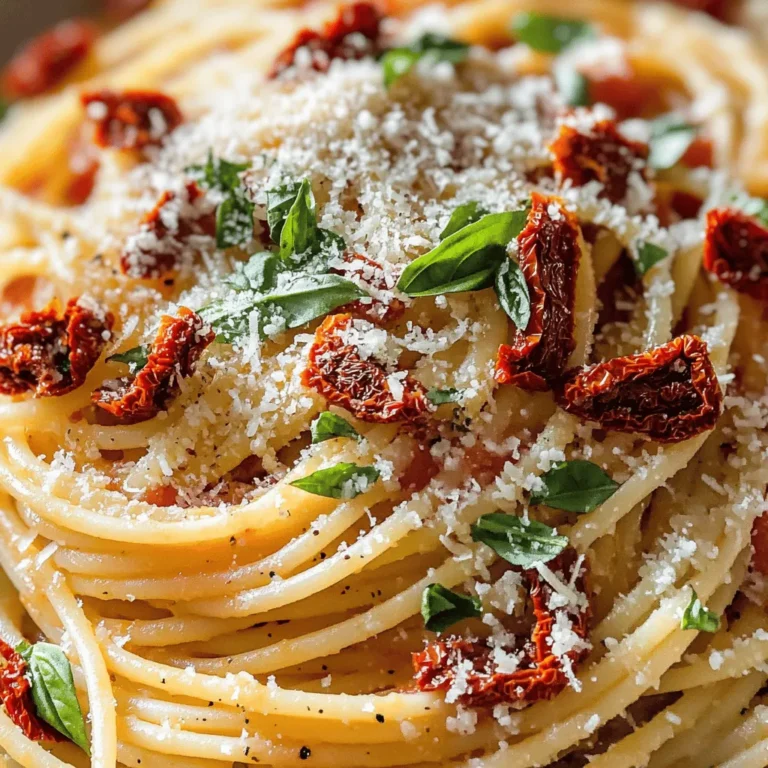If you crave a rich and flavorful spaghetti sauce, look no further! Making your own sauce at home is both fun and satisfying. In this guide, I’ll share my favorite recipe, tips for choosing the best ingredients, and simple steps to achieve perfect flavor. Whether you’re a novice or a cooking pro, you’ll find valuable insights to elevate your sauce. Let’s dive into the world of homemade spaghetti sauce!
Ingredients
List of Essential Ingredients
– Olive oil
– Onion
– Garlic
– Crushed tomatoes
– Sun-dried tomatoes
– Dried herbs and spices
– Salt and pepper
– Optional garnishes
Ingredient Tips
Best types of tomatoes to use
I recommend using San Marzano tomatoes. They are sweet and low in acidity. Canned crushed tomatoes work well for a thick sauce.
Fresh vs. dried herbs
Fresh herbs bring a bright taste. I love using fresh basil. Dried herbs have a strong flavor too. Use what you have and prefer.
Choosing sun-dried tomatoes in oil
Sun-dried tomatoes add rich flavor. Choose ones packed in oil for more moisture. They blend well into the sauce, enhancing the taste.
Recommended Equipment
Cooking utensils
You will need a large saucepan, a wooden spoon, and a sharp knife. A cutting board helps with prep.
Size and type of saucepan
A medium to large saucepan works best. It should be deep enough to hold the sauce. A heavy-bottomed pot helps prevent burning.
Step-by-Step Instructions
Preparation Overview
To start, gather all your ingredients. This makes cooking easier. You need:
– 1 tablespoon olive oil
– 1 medium onion, finely chopped
– 3 cloves garlic, minced
– 1 can (28 oz) crushed tomatoes
– 1/2 cup sun-dried tomatoes, chopped (in oil, drained)
– 1 teaspoon dried oregano
– 1 teaspoon dried basil
– 1/2 teaspoon red pepper flakes (optional for heat)
– Salt and pepper to taste
– Fresh basil leaves, for garnish
– Grated Parmesan cheese, for serving
Mise en place means “everything in its place.” Having all your ingredients ready helps you cook smoothly. It saves time and prevents mess.
Cooking Instructions
1. Heat the olive oil in a large saucepan over medium heat.
2. Add the chopped onion. Sauté it until it turns translucent, about 5-7 minutes.
3. Next, stir in the minced garlic. Cook for 1-2 minutes, till you smell its aroma.
4. Pour in the crushed tomatoes. Mix them well with the onion and garlic.
5. Add the chopped sun-dried tomatoes, dried oregano, dried basil, and red pepper flakes, if using. Stir everything together.
6. Bring the sauce to a simmer. Reduce the heat to low. Let it cook uncovered for 25-30 minutes. Stir occasionally to avoid sticking.
7. Taste your sauce. Add salt and pepper to adjust the flavor to your liking.
8. When the sauce thickens and the flavors meld, take it off the heat.
For perfect sautéing, watch the heat. If it’s too hot, the onions can burn. Stir often for even cooking.
Final Touches
After cooking, you might want to adjust the seasoning. Taste and tweak if needed. When ready to serve, ladle the sauce over cooked spaghetti. Garnish with fresh basil leaves and some grated Parmesan cheese. This adds great color and flavor!Enjoy your rich and flavorful homemade spaghetti sauce!
Tips & Tricks
Cooking Techniques for Best Results
To make your homemade spaghetti sauce shine, focus on flavor. Start with good olive oil. It adds depth. Sauté the onion until it’s soft and clear. This step builds a rich base. Then, add garlic. Just a minute or two is enough for a great aroma. Don’t rush this; it matters!
When using herbs, dried herbs work well, but fresh herbs can elevate your sauce. Add them towards the end of cooking for the best flavor. Avoid overcooking the sauce. A simmer for 25-30 minutes allows the flavors to blend nicely.
Common mistakes include adding too much salt early on. Taste as you go! If your sauce is too thin, let it simmer longer. You want a nice, thick sauce that clings to your pasta.
Serving Suggestions
For a delightful meal, pair your sauce with spaghetti, penne, or fettuccine. Each pasta type brings its own charm. Try a fresh salad or warm garlic bread on the side. This balance enhances your dining experience.
A sprinkle of grated Parmesan cheese on top adds a creamy finish. Fresh basil leaves also brighten the dish.
Making the Sauce Ahead of Time
Making your sauce ahead has many benefits. It allows the flavors to deepen, making it even better. You can store it in the fridge for about 3 days. For longer storage, freeze it!
To reheat the sauce, place it in a saucepan over low heat. Stir often to avoid burning. If it gets too thick, add a splash of water or broth. Enjoy your rich and flavorful delight whenever you crave it!

Variations
Vegetarian Options
For a meatless sauce, use hearty vegetables. You can add mushrooms, zucchini, or bell peppers. These add texture and flavor. Swap out meat for lentils or beans for protein. They work well in sauce and keep it filling.
Meat-Based Variations
Ground meat makes sauce rich and hearty. You can use beef, pork, or turkey. Brown the meat before adding other ingredients. This gives extra flavor. Mix meats for a more complex taste, like beef and sausage.
Other Flavor Profiles
Add more vegetables for depth. Carrots, celery, or spinach boost nutrition. You can also try creative swaps. Use roasted red peppers for sweetness or olives for a salty kick. Fresh herbs like parsley or thyme can brighten the sauce.
Storage Info
Storing Leftovers
To keep your homemade spaghetti sauce fresh, store it in the fridge. Use an airtight container. Glass jars or plastic containers work well. Let the sauce cool down before storing. This helps prevent condensation inside the container. Always label the container with the date. This way, you know when to use it.
Freezing Tips
If you have extra sauce, freezing is a great option. Divide it into smaller portions, so you can thaw only what you need. Use freezer-safe bags or containers. Remove as much air as possible to prevent freezer burn. To thaw, place the sauce in the fridge overnight. You can also use the microwave for quick thawing. When reheating, warm it on the stove over low heat. Stir often to ensure even heating.
Shelf Life
You can store homemade spaghetti sauce in the fridge for about 5 days. In the freezer, it lasts for about 3 months. Always check for signs of spoilage before using. If the sauce smells sour or has mold, it’s best to toss it. Fresh ingredients make a big difference in taste and quality. Always aim to use your sauce within the recommended time for the best flavor.
FAQs
What type of tomatoes are best for spaghetti sauce?
The best tomatoes for spaghetti sauce are Roma tomatoes. They have less water and more flesh. This makes a thicker sauce. Canned crushed tomatoes also work well. They save time and still taste great. Look for brands without added sugar or preservatives. You want pure tomato flavor.
Can I make homemade spaghetti sauce without fresh garlic?
Yes, you can make the sauce without fresh garlic. You can use garlic powder instead. Start with 1/4 teaspoon and add more if needed. The flavor may be milder. If you love garlic, consider adding roasted garlic for a sweet taste. It adds depth without being too strong.
How do I thicken my spaghetti sauce if it’s too watery?
To thicken your sauce, simmer it longer. Cook it uncovered to let steam escape. You can also add a bit of tomato paste or a cornstarch slurry. Mix 1 tablespoon of cornstarch with 2 tablespoons of cold water. Stir it into the sauce and cook until thickened.
– Other common questions related to seasoning and spices:
When seasoning, always taste as you go. Adjust salt and pepper to your liking. Fresh herbs can be added at the end for a burst of flavor. Dried herbs work well during cooking since they release their oils.
– Cooking time for different types of sauces:
A basic tomato sauce takes about 30 minutes to simmer. A meat sauce may need an hour for the flavors to meld. For a quick sauce, you can use fresh tomatoes and cook for 15-20 minutes. Each sauce has its own time for the best taste.
In this blog post, we explored making spaghetti sauce from scratch. We covered essential ingredients, tips for preparation, and step-by-step cooking instructions. I shared techniques to enhance flavors and options for variations, whether vegetarian or meat-based. You now know how to store leftovers and the best practices for freezing.
Remember, making your own sauce gives you control over flavor and freshness. Enjoy experimenting with ingredients to make it your own! Happy cooking!


